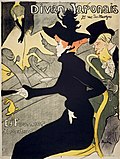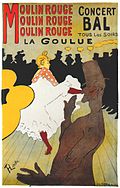Poster

A poster is a large piece of printed paper that has a message, usually with picture of something. Posters are made to be shown in public on a wall or other flat surfaces. They were the main form of public advertising before the web, and they are still used.
Posters are used for advertising, education, propaganda, and decoration.[1][2] They may also be copies of famous works of art.
Chromolithography and the poster
Chromolithography (color lithography) was invented by Engelmann & Son, who were granted a patent in 1837.[3] After that, it was a matter of time before it reached full commercial development.
Because of its low production costs, over the 50 years after the American Civil War, millions of chromolithographs were printed and were sold for under $10. Louis Prang, a Bostonian, produced fine-art subjects, such as still lifes, landscapes, and classical subjects.[4] Nevertheless, it was only after 1847 that the Jules Chéret posters showed their real potential.[5]
Examples
Jules Chéret
19th century posters in the US
- General source:[8]
Louis John Rhead
Louis John Rhead was English, sent to Paris at the age of thirteen to study under Boulanger. When he arrived in America in 1888, he was one of the leaders in the Art Nouveau movement. He created posters for Scribner's and Century magazines.[9]
In the 1890s Rhead designed nearly one hundred posters. In England and the U.S. he did memorable posters for magazines: Cassell's Magazine, the Weekly Dispatch, The Century, St. Nicholas, Harper's, The Bookman and Scribners'.[10]
In 1895 he won a gold medal for Best American Poster Design at the first International Poster Show in Boston. By the late 1890s, the popularity of poster art declined and Rhead turned his skills to book illustration.[11]
Edward Penfield
Edward Penfield was the “originator of the poster in America". Edward studied painting under the impressionist George de Forest Brush around 1890. He is mostly known for his advertising ‘placards’ for Harper's New Monthly Magazine.
Penfield’s first published work appeared in Harper's Weekly in 1891. In his early works, Penfield did ink and watercolor wash illustrations in a similar style to the older generation of graphic artists.[12]
His trademark linework and use of broad tonal areas developed after his return from Europe. There influences from Japanese prints, the Arts and Crafts movement, and the impressionistic approach of Parisian poster-making.[13]
Penfield is credited with bringing abstraction to commercial art through his boldly simplified shapes.[14]
Toulouse-Lautrec and Post-impressionism
Henri Raymond de Toulouse-Lautrec (1864-1901), the deformed son of an aristocratic family, went to Paris in 1882. He became a part of the bohemian community of Montmartre with its nightlife of cabarets, cafes, restaurants, sleazy dance halls and brothels. 1892/3.[15]
Lautrec was deeply influenced by Japanese woodblock printing: from the 1850s onwards, Japanese artwork flowed into the west. The nightlife of Montmartre inspired the content of his work. 1892.[16]
The women accepted him as a fellow outcast. They let him to wander about, sketching and painting freely. He grew close to his models, brought them presents, and took them to his studio, restaurants, circuses, or theatres during their time off. 1892.[17]
Lautrec wove the text into the graphics, but here there is almost no text. Still, this poster probably has all the necessary information. People would know who Cadieux was, and where the theatre was. Shows a terrific sense of movement. 1893.[18]
Art nouveau posters and the impact of graphics on painting
The English graphic artist Aubrey Beardsley illustrated periodicals. Clearly art nouveau, with elegant and flowing lines; and splendid elongated figures. Beardsley suggested vice and moral corruption, where Lautrec simply showed people.[19]
Alphonse Mucha was another influential Art Nouveau designer. The subjects of his posters are often beautiful, with joyous young women, flowing lines, and decorative flowers. He used an innovative soft pastel coloring scheme in his posters.[20]
Henri Privat-Livement's typical use of organic forms in this poster for a seaside casino.
The works of Gustav Klimt, the Austrian painter, are an example of the influence of graphic design on painting.[21] This portrait of Adele Bloch-Bauer shows many of the influences of the graphic design of those times.[22]
Posters in the first half of the 20th century
Posters were used for war propaganda, to encourage young people to enlist in the army, and to sell government war bonds. From a strictly artistic view, the posters were unimaginative and far from the masterpieces of the late 19th century posters. The posters almost all came with a caption to bang the message home.
No sign of art nouveau here; simplicity itself in a British poster designed for use in the USA. 1917.[23]
Among the propaganda war posters, this stands out, with its distinct blend of sympathy and help. Norman Rockwell, 1918.[24][25]
The French graphic artist Jean Carlu, who was influenced by cubism, had style. This 1942 war poster is tinged with Art Deco and streamlining.[26]
Poster Media
"Moulin Rouge - La Goulue" Toulouse-Lautrec, 1891 Lithograph poster for Ranch 10, a Western-themed play by Harry Meredith that opened in New York City in August 1882
Poster for Ringling Brothers (circa 1899) featuring Madam Ada Castello and her horse, Jupiter
German propaganda poster, Weimar Republic, 1921
"Fall In" war poster created [between 1914 and 1918] from the Archives of Ontario poster collection.
References
- ↑ Hillier, Bevis 1969. Posters. London: Weidenfeld & Nicolson.
- ↑ Barnicoat, John 1979. Posters: a concise history. London: Thames & Hudson. ISBN 0-500-20118-8
- ↑ Twyman, Michael 1970. Lithography 1800–1850. Oxford University Press. p160
- ↑ Gallo, Max 2002. The poster in History. W.W.
- ↑ Hutchinson H.F. 1968. The Poster: an illustrated history from 1860, chapter 2. London: Studio Vista. ISBN 978-0289278673.
- ↑ David Raizman 2003. History of modern design: graphics and products since the Industrial Revolution. Laurence King. ISBN 9781856693486
- ↑ Collins, Bradford R. (6 March 1996). Design history : an anthology. Cambridge, Mass.: MIT Press. pp. 41–50. ISBN 9780262540766. JSTOR 1511527.
- ↑ Margolin, Victor 1975. The golden age of the American poster. Ballantine Books. ISBN 978-0345251299
- ↑ Stanley Appelbaum 1990. The Complete «Masters of the Poster»: all 256 color plates from «Les Maîtres de L'affiche». Courier Dover ISBN 9780486263090
- ↑ "Smithsonian Institution". Archived from the original on 2012-04-15. Retrieved 2010-10-29.
- ↑ "Louis Rhead Obituary", New York Times (July 30, 1926)
- ↑ Wilczak, Susan A. The posters of Edward Penfield for Harper's New Monthly Magazine: a reflection of American society in the 1890s [Thesis]. Ann Arbor, MI: Department of Art, Michigan State University, 1996.
- ↑ Bauwens, Maurice; Hayashi, T.; La Forgue, Jules; Meier-Graefe, J.; Pennell, Joseph; and Boudét, G., editors. Les affiches étrangères illustrées. Paris: G. Boudet, 1897.
- ↑ Exman, Eugene. The House of Harper: One hundred and fifty years of publishing. New York: Harper and Row, 1967.Johnson, Diane Chalmers. American art nouveau. New York: Harry N. Abrams, 1979. Jones, Sydney R. Posters and their designers. London: The Studio, Ltd, 1924. Keay, Carolyn. American posters of the turn of the century. New York: St Martin's, 1975. Les maitres de l'affiche. 5 vols. Paris: Imprimerie Chaix, 1896, 1897, 1898, 1899, 1900. King, Julia. The flowering of Art Nouveau graphics. Salt Lake City, UT: Peregrine Smith Books, 1990. Maginnis, Charles. D. Pen drawing: an illustrated treatise, 1899. Malhotra, Ruth; Spielmann, Heinz; and Thon, Christina. Das frühe plakat in Europa und den USA: ein bestandskatalog. Band 1, Großbritannien vereinigte von Nordamerika. Berlin: Gebr. Mann Verlag, 1973. 43-173.
- ↑ Ackroyd, Christopher. Toulouse-Lautrec. Chartwell Books, 1989. The history and techniques of the great masters. Desloge, Nora. Toulouse-Lautrec: the Baldwin M. Baldwin Collection, San Diego Museum of Art. San Diego Museum of Art, 1988. D'esparbes, Georges et al. Les Demi-cabots, le café concert, le cirque, les forains. Paris, 1896. FeinbLlatt, Ebria & Bruce Davis. Toulouse-Lautrec and his contemporaries: posters of the belle époque from the Wagner Collection. Los Angeles County Museum of Art, 1985. Gauzi, Françoise. Lautrec et son temps. Paris, 1954. Zeldin, Theodore. France 1848-1945. Oxford and New York, 1977. Oxford history of modern Europe.
- ↑ San Diego Museum of Art. The Baldwin M. Baldwin Foundation Collection: graphics and other works by Henri de Toulouse-Lautrec. San Diego, 1980. Schimel, Herbert D. & Phillip Dennis Cate. The Henri de Toulouse-Lautrec and W.H.B. Sands correspondence. New York, 1983. Stuckey, Charles F. Toulouse-Lautrec paintings. Art Institute of Chicago, 1979. Sugana G.M. The complete paintings of Toulouse-Lautrec. New York, 1969.
- ↑ Adhemar, Jean. Toulouse-Lautrec: his complete lithographs and drypoints. New York, 1965. Adriani, Götz. Toulouse-Lautrec. London, 1987. Trans. Sebastian Wormell; first published Cologne, 1986.
- ↑ Joyani, Maurice. Henri de Toulouse-Lautrec; two vols. Paris, 1926-7. Weisberg, Gabriel P. et al. Japonisme: the Japanese influence on French art, 1854-1910. Cleveland Museum of Art, 1975. Wittrock, Wolfgang. Toulouse-Lautrec, the complete prints. London, 1985. Two vols.
- ↑ Calloway, Stephen. 1998. Aubrey Beardsley. New York, N.Y.: Harry N. Abrams. ISBN 0810940094.
- ↑ Anna Dvorak. “Illustrations for Books and Periodicals.” in Alphonse Mucha: the complete graphic works. Anne Bridges (ed). NY: Harmony, 1980.
- ↑ see Eva di Stefano 2008. Gustav KlimtL Art Nouveau Visionary. Sterling. ISBN 9781402759208
- ↑ Gilles Neret 1999. Gustav Klimt: 1862-1918. Taschen ISBN 978-3822859803
- ↑ Harper P. War, Revolution, and Peace, propaganda posters from the Hoover Institution Archives 1914-1945 [Stanford Art Department, Stanford Museum] [1969], Marshall Cavendish Collection, 'Selling the War' in Images of War No.64 (Marshall Cavendish, London) 1996. [1] Archived 2009-11-02 at the Wayback Machine. 2009-10-31.
- ↑ Norman Rockwell is considered the "quintessential middlebrow American artist".Kelly, Michael (1992-07-12). "The Candidates as Culture Vultures". The New York Times. Retrieved 2008-04-08.
- ↑ Some critics view his sentimental and nostalgic vision out of step with the harsh realities of American life, such as The Great Depression.Wright, Tricia (2007). "The Depression and World War II". American Art and Artists. HarperCollins Publishers. pp. 122–123. ISBN 978-0-06-089124-4.
- ↑ Art Deco Graphics, by Patricia Kery,Thames and Hudson; New edition (May 2, 2002), 0500283532, 978-0500283530. The birth of the modern poster, Mark Henshaw, the National Gallery of Australia, [2] Archived 2010-10-05 at the Wayback Machine
































